The MAB Hospital Ships, Long Reach, Dartford
From the outset, the smallpox and fever hospitals set up by the new Metropolitan Asylums Board (MAB) were the target of protests from those who lived near them. The first to be opened, at Hampstead in 1870, was delayed by local opposition to the scheme which involved Sir Rowland Hill, pioneer of the postage stamp, who owned a property adjacent to the hospital site.
The huge demand for hospital beds during the smallpox epidemic of 1870-71 outstripped the resources of the MAB's existing hospitals. In its first experiment with hospital ships, it chartered from the Admiralty the Dreadnought, moored off Greenwich and formerly used as the Seamen's Hospital. By mid-1871 the epidemic had abated and the Dreadnought was returned to the Admiralty.
In 1875, a parliamentary select committe investigating the Hampstead residents' complaints relating to the 1871 epidemic finally made its report. It concluded that the MAB had acted properly and that the problems were ones of individual carelessness and poor control of patients rather than to the presence of a smallpox hospital in the locality. Following a further smallpox outbreak in 1876, the Hampstead residents took the MAB to court, complaining of the injuries caused to their property and to the sanitary condition of the neighbourhood. In January 1879, a legal injunction was granted against the Board who were required to "stop carrying on the hospital so as to cause a nuisance". In 1881, at Fulham, local residents likewise applied for an injunction to prevent smallpox cases being placed at the Fulham Hospital. A compromise was reached whereby only cases discovered within a one-mile radius of the hospital would be admitted.
To deal with the growing difficulties facing its existing hospitals during a new smallpox epidemic in 1880-81, the MAB chartered two old wooden battleships from the Admiralty. A 90-gun ship, the Atlas, for acute cases, and a 50-gun frigate, the Endymion, for administrative functions, were converted at a cost of £11,000. The MAB originally wanted the Atlas to moored in Halfway Reach, near Dagenham. However, the Thames Conservancy, who were responsible for the river, insisted on moorings off Deptford Creek at Greenwich, close to where the Dreadnought had been sited. The Atlas received her her first patients on 13th July, 1881. A horse-drawn ambulance service to and from the ships was set up from a rented house in London Fields in East London which had a direct telephone link to the Board's head office. Again, there was fierce local opposition to the presence of the establishment.
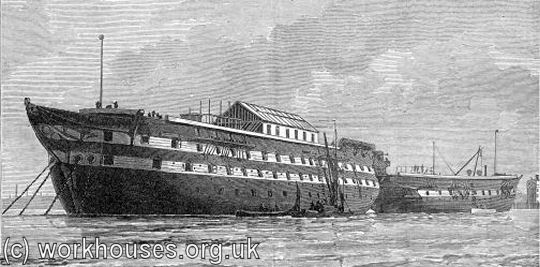
The Atlas and Endymion at Deptford Creek, 1881.
© Peter Higginbotham
In response to the growing concerns, a Royal Commission was appointed in 1881 to examine the arrangements for dealing with infectious diseases in the capital. In its report the following year, it recommended that smallpox cases be treated in isolated hospitals on the banks of the Thames or in floating hospitals on the river itself. In addition, convalescent hospitals were to be established at some distance in the country, and a central ambulance service should be established.
In 1883, the Atlas and Endymion were moved to new moorings at Long Reach near Dartford, 15 miles below London Bridge. They were joined by a third vessel, the Castalia, a former passenger ferry which the MAB had acquired from the English Channel Steamship Company. The three ships were moored in a line 150 yards from the bank and linked together by communicating bridges.
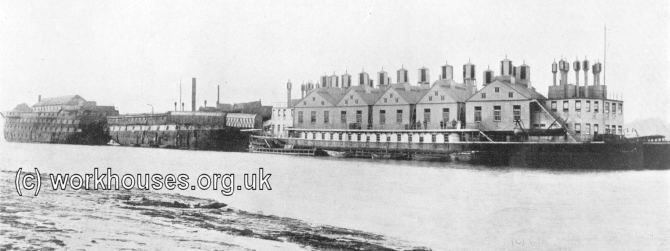
The Atlas, Endymion and Castalia
© Peter Higginbotham
The Atlas
The Atlas accommodated male patients and could provide up to 200 beds on its main, lower and orlop decks, together with isolation wards on its upper deck. New patients were admitted to the reception rooms on the orlop deck and raised by a lift to the upper decks. The Atlas also contained the dispensary and quarters for the medical staff.
The Endymion
The Endymion, at the centre of the trio, was used for administrative purposes. It had a kitchen on its main deck, and mess rooms for staff and stores on the deck below. It also contained the quarters for the steward, the matron, the male staff, and some female staff.
Heating for all the ships was by steam generated in the hold of the Endymion and conducted to its neighbours by flexible piping. The steam was passed through coils to warm the air passing through the fresh air inlets. Each ship also had its own boiler as a reserve in case of accident. There were no fireplaces or heating stoves on any of the ships.
The Castalia
The Castalia was an iron twin-hulled paddle steamer built in 1874 by the Thames Iron Works. She had been constructed to carry passengers between Dover and Calais. With an engine in each hull, she could manage up to 11 knots but proved to be a poor sea-going boat in the often turbulent waters of the English Channel. As a result, her owners moth-balled her until 1883 when the MAB purchased her.
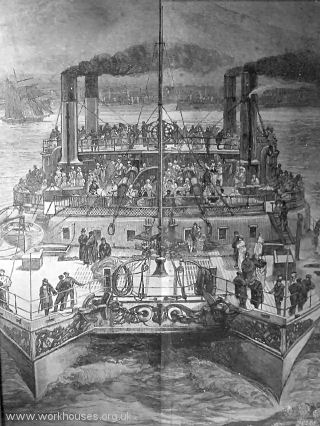
Artist's impression of the Castalia in its intended passenger ferry service
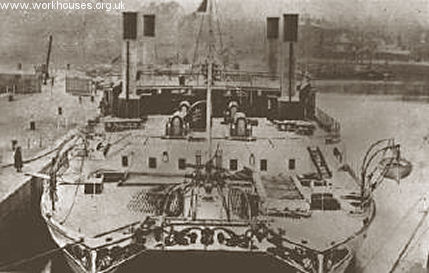
The Castalia prior to conversion
For conversion to a hospital ship, both engines and paddle wheels were removed and the space decked over to form an upper and lower hospital. The vessels's eight-foot iron-girder construction divided the lower deck into five wards. On the platform constructed above, five wards placed echelon-style were constructed, together with a reception room, isolation wards, baths, lavatories and latrines. The ship, which came into service in July 1884, provided 154 beds for female patients, 84 in the lower hospital, and 70 in the upper.
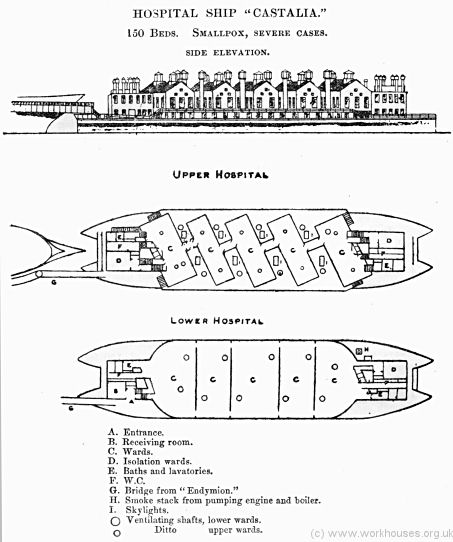
The Castalia hospital ship layout, 1884.
© Peter Higginbotham
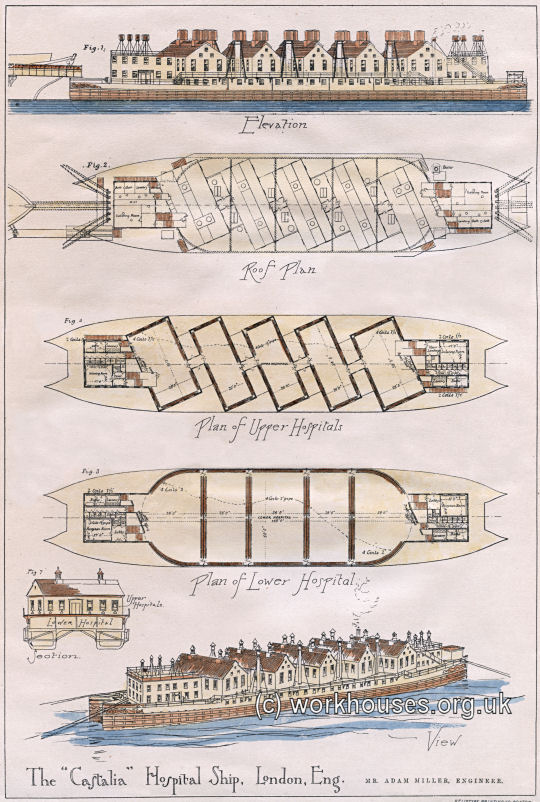
The Castalia hospital ship layout, 1884.
© Peter Higginbotham
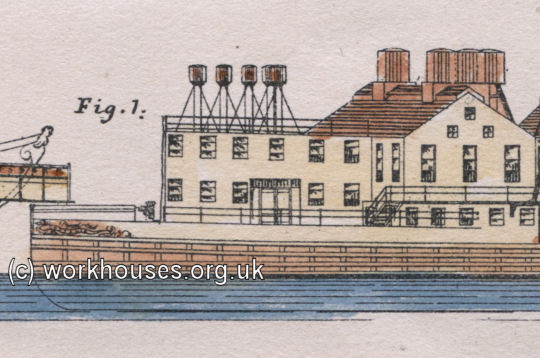
The Castalia hospital ship detail, 1884.
© Peter Higginbotham
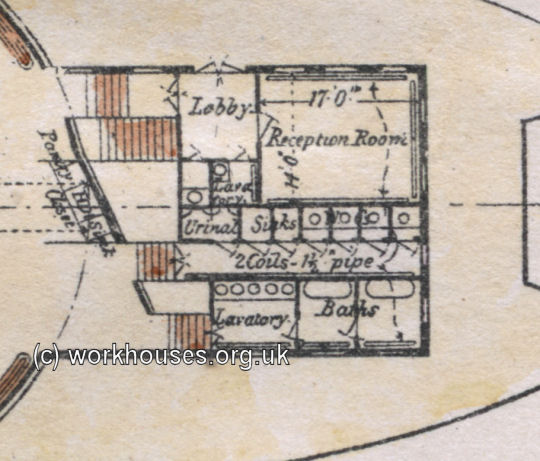
The Castalia hospital ship detail, 1884.
© Peter Higginbotham
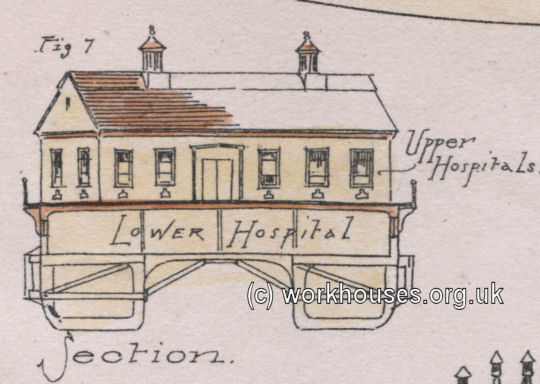
The Castalia hospital ship detail, 1884.
© Peter Higginbotham
Ventilation was achieved by two tall shafts into each ward fitted "Boyle's" extractors. Wind blowing from any direction created an upwards draught in the shafts giving an average throughput of 1,200 cubic feet a minute which replaced all the air in the hospital nine times an hour. In case of a dead calm, a pumped fan created an artificial draught through the shafts.
Before leaving the ships, staff had to undertake a thorough bathing, wash their hair, and change into a set of clothing kept separate from their hospital clothing.
As with the land-based smallpox hospitals, the hospital ships were viewed with concern by local residents. Their fears were fuelled in March, 1885, when a Miss Willis died two weeks after dancing with Stores Porter Davidson, one of the ships' crew, at a ball in the nearby port of Erith. A local doctor, J Clarkson Maynard, had diagnosed the cause of death as malignant smallpox. In reply, Dr RA Birdwood from the Hospital Ships stated that, upon enquiry, Miss Willis had not had the skin eruptions characteristic of smallpox, and had died after just three hours illness, bringing up blood. He also stressed the precautionary measures taken by staff leaving the ships. No firm conclusion was ever reached on the cause of Miss Willis's death. However, the MAB introduced a policy that all supplies for the Hospital Ships henceforward be delivered by ambulance steamers from London rather than coming by rail or being purchased locally.
The Long Reach Pier Buildings
As well as the ships themselves, a suite of service buildings was erected opposite the ships on shore at Long Reach. These included sleeping accommodation, baths and dressing rooms for the nurses and female attendants, engines and dynamos for the electric lighting of the whole establishment. Stables and a mortuary were included in separate blocks nearby.
The landing pier provided the terminus for the MAB's new river ambulance service which transported patients along the Thames to and from the hospital ships and also the convalescent hospital at Gore Farm, four miles away.
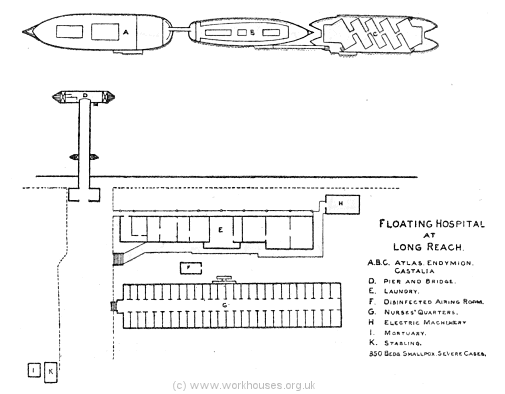
Long Reach shore buildings, 1890s
© Peter Higginbotham
In 1897, a tramway was constructed to transfer patients between the pier and the various hospital buildings in horse-drawn tram-cars
© Peter Higginbotham
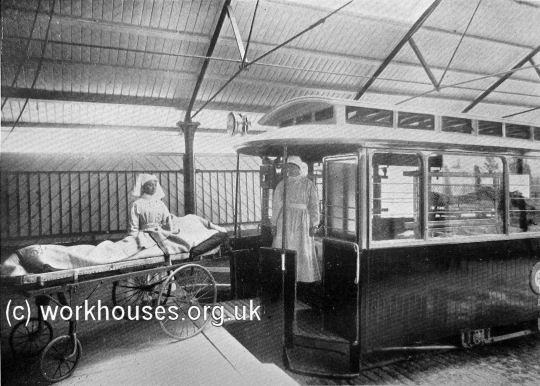
Patient being transferred to a tram-car at Long Reach, early 1900s.
copy; Peter Higginbotham
The hospital ships continued in use until 1903 when the permanent Joyce Green smallpox hospital was opened on a site nearby. Two temporary hospitals, the Long Reach Hospital and the Orchard Hospital were also opened on nearby sites during a serious smallpox outbreak in 1901-2. The old ships were disposed of shortly afterwards by auction at the Bull Hotel, Dartford. The Atlas was sold for £3,725, the Endymion for £3,200, and the Castalia for £1,120. It was a condition of sale that the vessels had to be removed within two months, after which a rental of £25 per week would be charged.
The Long Reach pier buildings have been demolished and a flood defence barrier now occupies the site.
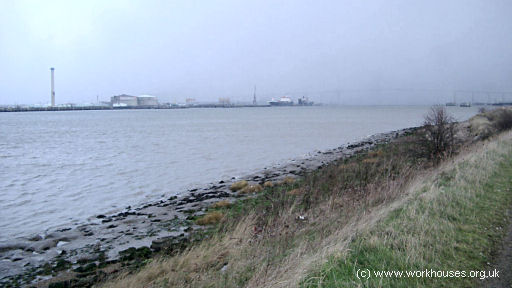
Long Reach, 2005
© Peter Higginbotham
Records
Note: many repositories impose a closure period of up to 100 years for records identifying individuals. Before travelling a long distance, always check that the records you want to consult will be available.
- London Metropolitan Archives, 40 Northampton Road, London EC1R OHB. Has virtually all the surviving records for the Metropolitan Asylums Board and its instititutions. Search their catalogue at https://search.lma.gov.uk/.
Bibliography
- Ayers, Gwendoline, M. (1971) England's First State Hospitals and the Metropolitan Asylums Board (Wellcome Institute of the History of Medicine, London).
- Bostock, C.B and Barrington, V.K. (1893) The Hospital and Ambulance Organisation of the Metropolitan Asylums Board (MAB, London)
- Burne, JC (1973) The long reach hospital ships and Miss Wills (Proc Roy Soc Med 66; 1017-1021<)/li>
- Burne, JC (1989) Dartford's Capital River (Barracuda Books, Buckingham)
- Powell, Sir Allan (1930) The Metropolitan Asylums Board and its Work, 1867-1930. (MAB, London)
Links
- None.
Unless otherwise indicated, this page () is copyright Peter Higginbotham. Contents may not be reproduced without permission.


